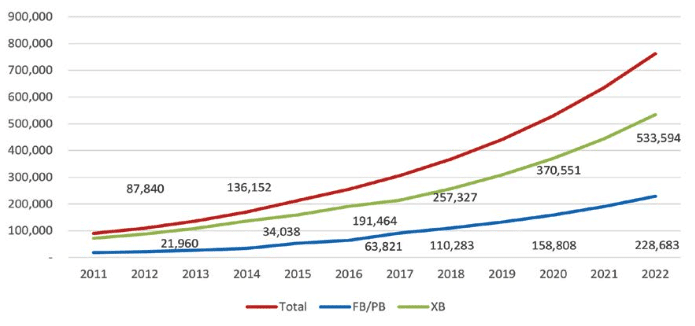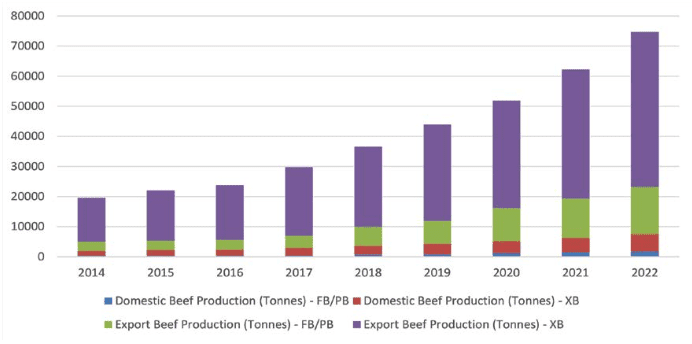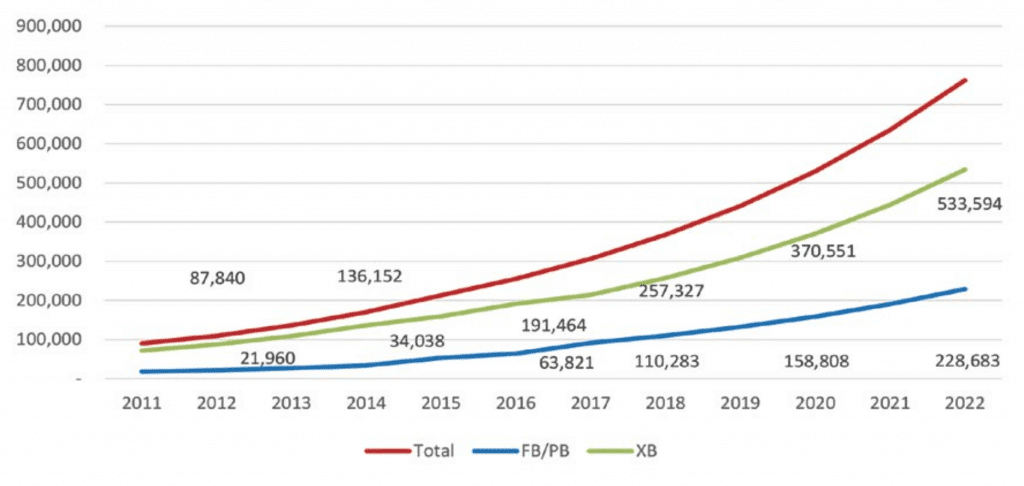
Total Wagyu beef projection across all categories from the updated (2017) model vs the original (2014) model. Source: AWA.
AUSTRALIA’S production of Wagyu beef is expected to grow significantly in the next five years, however at a slightly less rapid rate than previously predicted.
Earlier this year the Australian Wagyu Association conducted a survey of members to gain, among other things, clearer insights into the composition, size and expected growth of Australia’s Wagyu herd and beef production trends to 2022.
More than 200 Wagyu producers responded to the March to June 2017 survey, representing about 40 percent of the AWA’s total membership at the time.
Responses from members were then applied to AWA and Meat & Livestock Australia models to provide a picture of current and predicted Wagyu beef output levels*.
The survey builds on a similar survey conducted in 2014.
Key findings included projections that total Australian Wagyu beef production will grow three-fold from an estimated 24,000 tonnes in the current 2017 year to 74,703 tonnes by 2022.
This amounts to an expected average increase in production of 21 percent per year for the six years to 2022.
This is however a more moderate growth rate than that forecast in 2014, which was based on a 30pc annual growth rate and predicted total production to reach 125,913t by 2022.
AWA CEO Dr Matt McDonagh said the association’s original growth rate forecasts in 2014 were based on one point in time and the projected increases in Wagyu production from its members at that time.
The 2017 forecasts are based on what was achieved over the last three years and projecting out from this level of growth to 2022.
Number of Fullbloods to increase significantly
The latest survey results indicate that Fullblood and Purebred joinings currently represent approximately 30pc of estimated national total Wagyu numbers.
Crossbred production is projected to increase more than two-fold to 2022, but, in an indication more producers are looking to increase the quality of their herds, Fullblood/Purebred production levels are set to increase approximately four-fold within the next five years.
“The level of artificial breeding as a proportion of total Fullblood breeding is high in Wagyu compared to other breeds, accounting for approximately 50pc of all joinings,” Dr McDonagh said.
“The majority of artificial breeding is Fullblood embryo production, which allows for rapid amplification of superior genetics.
“Because of this, we project that the numbers of Fullbloods will increase significantly over the coming three years as producers utilise recipients from other breeds to quickly increase their herd sizes”.
85pc of respondents had Wagyu operations in NSW, Queensland and Victoria, consistent with the proportionate representation within the AWA membership.

Categorised Wagyu beef production projection across categories and by market type (export vs domestic) from the 2017 model. Source: AWA
Key findings included:
- The Australian Wagyu industry is rapidly increasing in size, with one in five respondents not involved in the industry at the time of the last AWA survey three years ago.
- The largest portion of industry (35pc) have been in Wagyu production for less than five years.
- Family operations account for 74.5pc of the AWA’s membership base, followed by family owned corporates (18.8pc) and corporate owned operations (6.7pc).
- Wagyu herd sizes are increasingly rapidly. Three years ago approximately 50pc of herds were classified as small (less than 100 head. That figure has dropped to 28pc in the 2017 survey. The AWA says this figure is likely to halve again over the next five years (through organic growth of herds and potential amalgamation of smaller herds).
- The proportion of members with more than 1000 head of Wagyu on their farm in 2014 was 11 percent. In the 2017 survey, that figure has risen to 18pc. Within five years, the AWA predicts 60pc of members will have operations between 100 and 1000 head.
- Most AWA members rely on Wagyu for most or all of their income (average 67pc). Across all AWA members, the majority of farm income is generated from commercial crossbred Wagyu production.
- Most respondents have a cross over of Fullblood/Purebred production, crossbred productions and seedstock/genetics, with only 36pc mentioning just one type of income generating activity.
- Commercial production of Fullblood and Crossbred animals accounts for 73pc of producer income, with 27pc from seedstock/genetics sales.
- Total production of Wagyu beef, based on the AWA’s modeling of individual herd data from the survey, is projected to increase to 74,703 tonnes by 2022. This is up from estimated production of 24,000 tonnes for the current 2017 year.
- This amounts to an average increase in production of 21 percent per year for the six years to 2022.
- This projection is lower than forecast in 2014 which was based on a 30pc annual growth rate and predicted total production to reach 125,913t by 2022. (These production estimates are derived from total numbers of Wagyu Fullblood/Purebred and crossbred joining, which indicates the more moderate (approximately 20pc) increase in total growth rate to 2022.
- As a proportion of total Wagyu numbers, natural Fullblood and Purebred joinings are approximately 30pc of the estimated national total.
- Export Fullblood/Purebred production is still expected to account for approximately 90 percent of total production.
- Crossbred production is projected to increase more than two-fold, with Fullblood/Purebred production to increase approximately four-fold to 2022.
* It is important to note that the information used to derive the trends projected is dependent on the quantity and quality of information provided by respondents to the AWA member survey, and it is the information upon which the conclusions are derived.




The survey was of Wagyu members only. I believe there are quite a few new entrants into the game, a lot of those just starting with 1st cross, so believe numbers will be significantly higher than the survey indicates.